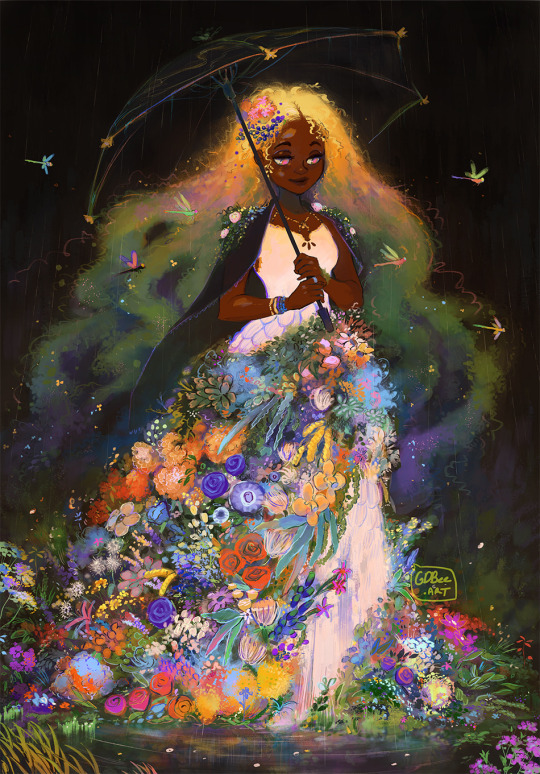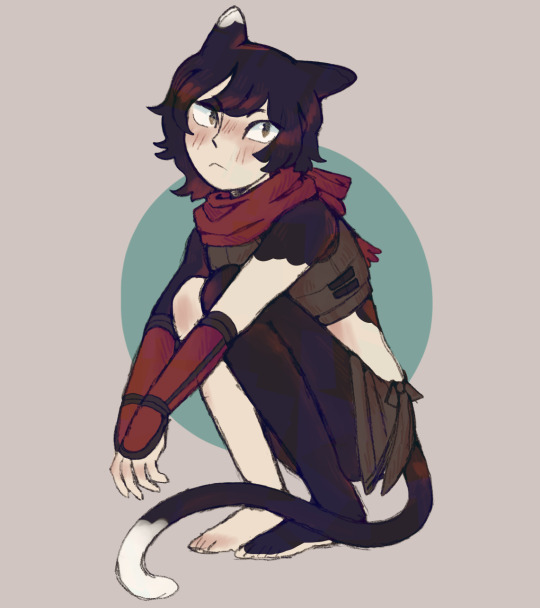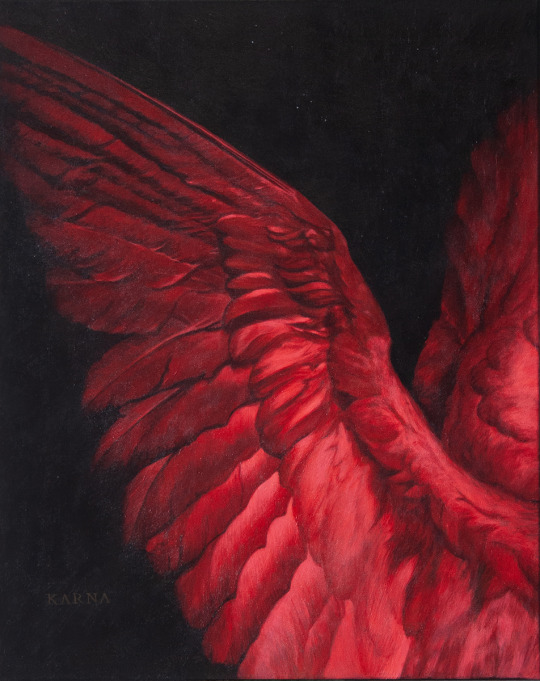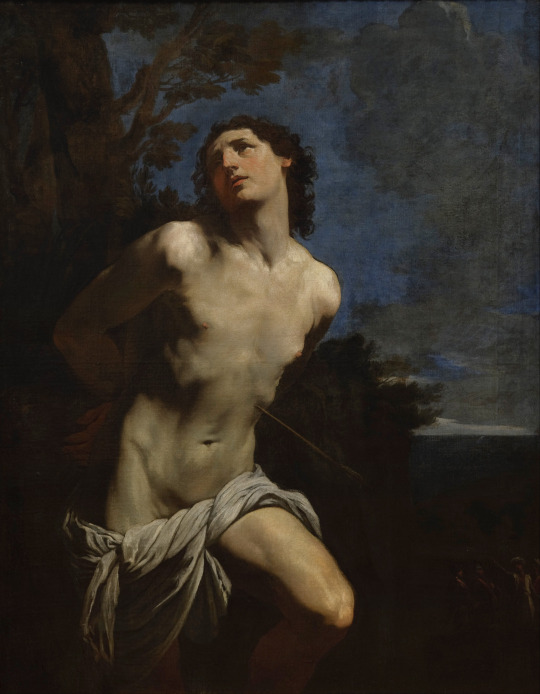#Renaissance artist
Explore tagged Tumblr posts
Text

KNIGHT, DEATH AND THE DEVIL | 1513 | by ALBRECHT DÜRER
The central figure in the engraving is a knight on horseback, wearing a suit of armor and carrying a lance and a sword. He is accompanied by a dog, which is often seen as a symbol of loyalty and faithfulness. The knight's determined expression and strong posture suggest a sense of courage and moral fortitude.
The knight is riding through a rocky landscape, with the horse's hooves creating a sense of movement and energy. The landscape is filled with symbolic elements, such as the serpentine road that winds through the rocky terrain, which has been interpreted as a symbol of the difficult path of life. In the distance, a city can be seen, perhaps representing the ultimate goal of the knight's journey.
The figure of DEATH appears on the left side of the engraving, riding a horse and holding an hourglass. This depiction of DEATH as a skeleton was a common motif in Renaissance art and was often used as a reminder of the inevitability of death. The fact that the knight is not looking at DEATH, but rather straight ahead, suggests his bravery and determination in the face of mortality.
On the right side of the engraving, a figure of a DEVIL can be seen, carrying a bagpipe. This figure is often interpreted as representing temptation and the distractions of the earthly world. The knight's steadfast focus on his journey, despite the presence of DEATH and the DEVIL, reinforces the theme of moral fortitude and courage.
The engraving is rich in symbolism and has been subject to many interpretations. Some see it as a representation of the Christian virtue of fortitude, with the knight representing the CHRISTIAN soul on a journey through life, facing the temptations and trials of the world. Others see it as a commentary on the political and religious turmoil of the time, with the knight representing the virtuous individual navigating through a corrupt and dangerous society.
#knight death and the devil#knight#death#the devil#albrecht dürer#northern renaissance#early renaissance#renaissance artist#renaissance art#art#history art#history painting#renaissance
13 notes
·
View notes
Text



Many an artist dreams of leaving a legacy that cements their place in history, but some of them miss perhaps the simplest step in that process: signing one’s work.
That’s the case with a group of paintings being presented for an exhibition at Compton Verney in England, Tudor Mystery: A Master Painter Revealed, which seeks to put a name to a Tudor-era painter whose identity has been obscured by time, though his subjects were extremely venerable.
25 notes
·
View notes
Text

Been re-watching gravity falls for the summer
#new sticker design? maybe??#dipper pines#mabel pines#gravity falls#fanart#my art#sticker design#artists on tumblr#digital art#pines twins#I’m so glad it’s having a renaissance lol#they’re soooooo cute#bill cipher#he’s there you just gotta look
29K notes
·
View notes
Text



miku renaissance 🪩
#had one more miku in the vault#beyonce 🤝🏾 miku - being iconic virgos#my art#digital art#clip studio paint#artists on tumblr#miku hatsune#hatsune miku#vocaloid#fanart#miku#beyonce#renaissance#csp#ch: miku hatsune
23K notes
·
View notes
Text




















Cats Stealing Food in Paintings
Still Life with Cat (1705) by Desportes, It's no use crying over spilt milk (1880) by Frank Paton, Still Life of the Remnants of a Meal with a Lunging Cat (18th Century) by Alexandre-François Desportes, Fish Still Life with Two Cats (1781) by Martin Ferdinand Quadal, Still Life with a Cat and a Mackerel on a Table Top (18th Century) by Giovanni Rivalta, The Collared Thief (1860) by William James Webbe, Cat Stealing a String of Sausages (17th Century) by Abraham van Beyeren, Still Life with a Cat (1760) by Sebastiano Lazzari, Kitchen Still Life with Fish and Cat (ca. 1650) by Sebastian Stoskopff, An Oyster Supper (1882) by Horatio Henry Couldery, Still Life with an Ebony Chest (17th Century) by Frans Snyders, Still Life with a Cat (1724) by Alexandre-Francois Desportes, A Cat Attacking Dead Game (18th Century) by Alexandre-François Desportes, Still Life of Fresh-Water Fish with a Cat (1656) by Pieter Claesz, Still Life with Fruits and Ham with a Cat and a Parrot (18th Century) by Alexandre-Francois Desportes, A Cat Holding a Fish in Its Mouth (18th Century) by Sebastiano Lazzari, Still Life with a Cat and a Hare (18th Century) by Desportes, Still Life with Cat and Rayfish (1728) by Jean-Siméon Chardin, A Cat with Dead Game (1711) by Alexandre-Francois Desportes, Still Life with Cat and Fish (1728) by Jean Baptiste Siméon Chardin
Via James Lucas on X/Twitter
#cat#cats#art#artist#artblr#painting#oil on canvas#oil painting#artists#classical art#animals#pet#pets#cute#wholesome#funny#classic academia#historical painting#historical art#art history#renaissance art#renaissance#renaissance painting#paintings#fine art#art gallery#art community#art blog#kitten#kittens
24K notes
·
View notes
Text

Stroll in the Rain
#image description in alt#artists on tumblr#renaissance-lite#floral dress#yet another dress I wish was real
33K notes
·
View notes
Photo

Saint Catherine (detail), After Bernardino Luini, 1510 .
#saint catherine#Art#Artedit#bernardino luini#italian renaissance#italian artist#religious art#art detail
6K notes
·
View notes
Text

"Girl in Pink Dress" by Laura Wheeler Waring 1927
#laura wheeler waring#black women#woc beauty#oil painting#black artist#harlem renaissance#classic art
8K notes
·
View notes
Text

Maxfield Parrish, Sleeping Beauty in the Wood (1912)
#classic art#art detail#traditional art#traditional painting#classical art#oil painting#art history#art details#art#19th century art#vintage art#arte#artist#artwork#1800s art#20th century art#art nouveau#academic art#british art#contemporary art#fine art#german art#italian art#modern art#renaissance art#spanish art#victorian art#drawing#art study#gorgeous women
3K notes
·
View notes
Text

anyone know if we have catgirl tomorrow
#my art#fanart#dungeon meshi#delicious in dungeon#izutsumi#noticing all my mistakes as i post lol.#dunmeshi is the only thing i care enough abt to do fanart for rn but all the artists here are like. renaissance level. wtf.#anyway. izutsumiiii i love u#HUH. mine first art to reach 1k notes. i wish i did better LMAO u are all so niceys 2 me
4K notes
·
View notes
Text

𝑅𝑒𝑑 𝑤𝑖𝑛𝑔𝑠
Instagram
#artists on tumblr#dark art#art#dark aesthetic#gothic#demoness#демоница#lilith#lucifer#demon#baroque#renaissance#redaesthetic#painting#wings#fallen angel#witchblr
7K notes
·
View notes
Text

SAINT JEROME IN HIS STUDY | c.1474 | by ANTONELLO DA MESSINA
This is a masterpiece that portrays SAINT JEROME, a scholar and monk known for translating a large part of the Bible into LATIN. The painting, showcases SAINT JEROME in his study, surrounded by symbolic elements like books, animals, and pottery, all meticulously detailed.
The scene is set in a room without walls or a ceiling, possibly within a Gothic monastery, with light rays emphasizing the saint's torso and hands. The painting's architectural qualities and intricate details reflect ANTONELLO'S skill and creativity, influenced by fifteenth-century FLEMISH ART.
ANTONELLO'S unique portrayal of SAINT JEROME stands out due to the masterful composition and use of perspective, with the saint placed at the center of the painting, drawing the viewer's focus. The painting's setting, resembling a church interior with vaults and windows, highlights the saint's dedication to prayer through reason, aligning with the humanist era's virtues.
Symbolism plays a significant role in the painting, with elements like the peacock symbolizing CHRIST'S virtues of immortality and eternal glory. Additionally, the partridge in the painting connects to SAINT JEROME'S writings, serving as an allegory for those who accumulate riches unjustly. ANTONELLO'S deep connection to his hometown, MESSINA, is subtly depicted in the painting, showcasing a panorama of MONTE SANTO DI CAMARO and MESSINA'S landscape through the windows.
8 notes
·
View notes
Text

San Francisco’s Legion of Honor is set to showcase the first major exhibition dedicated to Sandro Botticelli’s drawings this fall.
Known for masterpieces such as “Primavera” and “The Birth of Venus,” the exhibition will feature five newly attributed drawings as well as a variety of rarely seen preparatory sketches that unpack the design process for several of Botticelli’s iconic paintings.
15 notes
·
View notes
Text
hot twink is tied up and penetrated








A Collection of Homoerotic Paintings of Saint Sebastian
Carlo Saraceni, c. 1610 /// Nicolas Régnier, c. 1620 /// Guido Reni, c. 1625 /// Nicolas Régnier, c. 1625 /// Louis Finson, c. 1613 /// François-Guillaume Ménageot, c. 1760 /// Guido Reni, c. 1615 /// Nicolas Régnier, c. 1620
#academic writings about saint sebastian are so funny cos they're all like:#'yeah he isn't a very important catholic figure or anything. renaissance artists just really liked painting him. hmmm'#the bottom left one. he doesn't even have any arrows. dude you didn't even try to hide what you were doing#renaissance art#renaissance#baroque#baroque art#saint sebastian#gay#< I hope my gay brothers appreciate this#art#oil painting#catholic art
5K notes
·
View notes
Text

is this guy bothering you queen?
#back after a few years with more art because i now have two degrees and no job lets GOOO#where were you during the beetlejuice renaissance of 2024#beetlejuice#beetlejuice cartoon#beetlejuice art#lydia deetz#toonjuice#nat's art#artists on tumblr
1K notes
·
View notes
Text
Embroidery by Kathrin Marchenko
#art#artist#artblr#embroidery#fallen angel#the fallen angel#baroque art#baroque#renaissance#renaissance art#dark academia#light academia#classic academia#classical art#art history#museum#aesthetic#artists#artists on tumblr#art community#art gallery#art blog#historical art
8K notes
·
View notes